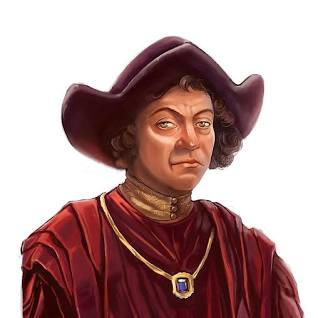The REAL Story of Christopher Columbus and the Slave Trade
Think about it before you celebrate the next "Columbus Day."
Christopher Columbus: Don’t believe what you’ve been taught…
Issue #392 American History October 3, 2023
Christopher Columbus did not “discover” the Americas, nor was he even the first European to visit the “New World.” (Viking explorer Leif Erikson had sailed to Greenland and Newfoundland in the 11th century.)
According to the History Channel, Columbus is remembered as a daring and path-breaking explorer who transformed the New World, yet his actions also unleashed changes that would eventually devastate the native populations he and his fellow explorers encountered.
My friend, fellow educator, and frequent podcast guest Jamon Jordan is the Official Historian for the City of Detroit, an adjunct professor at the University of Michigan, the leader of Black Scroll Network History and Tours, and the former president of the Detroit Chapter of the Association for the Association for the Study of African American Life and History (ASALH), founded by Dr. Carter G. Woodson, my great-grand uncle. Jamon regularly posts comprehensive history lessons on Facebook and gives me his permission to re-post.
Here is Jamon's annual reminder post about Christopher Columbus.
Since 1441, Africans have been enslaved, mainly by the Portuguese, on islands in the Atlantic, like the Azores, Madeira, Cape Verde, and São Tomé. They’re also being taken to Portugal itself and being sold and traded there. This is the Atlantic Slave Trade.
In January of 1492, the Spanish forces of Ferdinand and Isabella defeated the Moors (North African Muslims), and they began expelling Moors from Spain. This is known as the Reconquista. Some of the Moors were caught in the Spanish Inquisition, which began during the reign of Ferdinand and Isabella.
In many cases, these Moors, who were Muslim, were not allowed to go into exile back to North Africa. They faced conversion or death. If they converted to Catholicism, they were known as "Moriscos." Jews in Spain and Portugal were also tortured and forced to choose death or conversion. Jews who converted were known as "Marranos" or "Conversos."
By March 1492, most of the Moors who had not converted were expelled. While Ferdinand and Isabella were leading the Reconquista in Spain in the 1480s, an Italian sailor named Cristoforo Columbo had been petitioning the Portuguese royal family to fund his planned expedition to the Indies.
Instead of going around Africa, or going through the Arab-controlled lands of North Africa and Southeast Asia, he planned to go west - around the globe - to reach the Indies in the east. The Portuguese called him Cristóbal Colón.You know him as Christopher Columbus.
However, after Portuguese explorer Bartolomeu Dias became the first white man to reach the tip of southern Africa and the Indian Ocean in 1488, the rulers of Portugal no longer entertained the ideas of Columbus.
Columbus then lobbied Henry VII - the king of England - to no avail. In 1492, as Ferdinand and Isabella were expelling the Moors, Columbus was in Spain, urging these Spanish monarchs to support his plans. Isabella refused to support his endeavor, and Columbus was on his way to France to beg King Charles VIII for money. Before he left Spain, Ferdinand stopped him and agreed to a small level of funding for his voyage.
In August 1492, Columbus left Spain with 3 ships - the Niña, the Pinta, and the Santa Maria. Christopher Columbus sailed, on behalf of himself and Spain, to what he thought was the Indies, to obtain silk, spices, gold, converts, and new territories.
He arrived on October 12, 1492, in what is now the Bahamas, and since he thought he was in the Indies, he named the people, "los indios" - the Indians. Columbus had already been involved in the Atlantic Slave Trade and even helped the Portuguese build Elmina Castle, the notorious slave fort in what is now Ghana.
Columbus wrote about enslaving the Indigenous People, and then he forced the Indigenous People into labor and took some captives back to Spain. Thus began the rarely discussed Transatlantic Slave Trade of Native Americans. This slave trade system interfaced with the already established slave trade of Africans.
As Native Americans were forced into slavery in the ‘New World’ and Europe, Africans, who were enslaved on Atlantic islands and also in Europe, began being transferred to the New World as ‘slaves,’ with sugar being the economic foundation.
Columbus would make 4 voyages to the Americas between 1492-1504. When he came back to the Americas on his 2nd voyage in November of 1493, he landed on what is now the island of Dominica. He seized hundreds of Taino people and had them sent by ship to Spain, initiating the Transatlantic Slave Trade.
After removing through slavery these Taino people from the island he named Hispaniola, he then established the first European colony in the so-called "New World" since the Vikings were chased away 500 years prior.
He names his colony, "La Isabela," in a shallow attempt to curry favor with Queen Isabella of Spain. Today, that colony is the Dominican Republic. But Columbus did not "discover" America.
But let's give him credit for what he did do: He began a process of genocide against the Indigenous People in the Americas, that was taken up by the Spanish, the Portuguese, the British, and the French. He started the "Transatlantic Slave Trade."
Columbus is the first recorded sex trafficker in history. He captured Indigenous girls and sold them into slavery in Spain. His Spanish male customers preferred the girls to be around 9 years old.
Did you learn anything new about Christopher Columbus? Let’s discuss this in the Substack Notes feature!
We depend on you to help us to grow “We Are Speaking!”
We appreciate every one of our subscribers, but our paid subscribers help financially support our 7-day-a-week publishing schedule. Please upgrade your subscription to a paid level at no more than $5/month.





